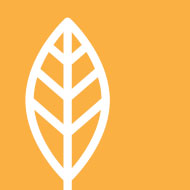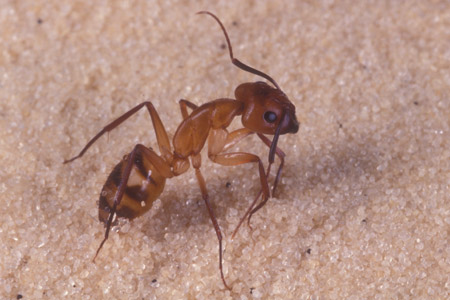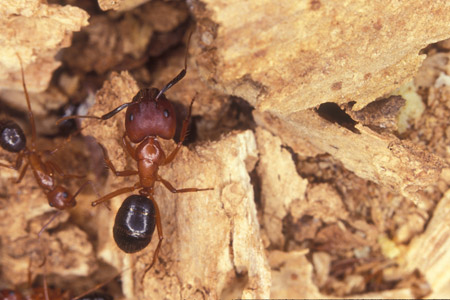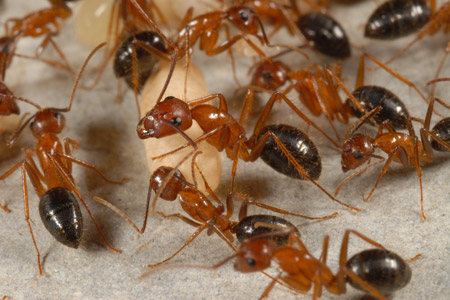Active Seasons




Florida Carpenter Ant Appearance and Size Facts
One of Florida’s most common pests is the carpenter ant. These ants may seem harmless at first, but they can indicate significant structural damage to your home from moisture and termites. It is important to identify these pests and employ effective control measures to prevent any further damage.
Florida carpenter ants are typically reddish-brown or black in color and range from 1/4 to 1/2 inch in size. They have an oval-shaped body with six legs and elbowed antennae. Despite their size, these ants have powerful jaws that allow them to chew and nest within moist and water-damaged wood, exacerbating structural damage to your home.
Identifying Florida Carpenter Ants From Other Ants
What distinguishes Florida Carpenter Ants are their robust build, prominent thorax, and consistent coloring throughout their bodies. Their segmented bodies feature a well-defined waist, and they possess powerful mandibles used for excavating wood. Unlike some other ant species, Carpenter Ants don’t have a stinger but can deliver a painful bite if provoked. They often nest in wood; if you observe large, solitary ants in or around your home, especially near wooden structures, it’s essential to consult with a pest control professional to make a definitive identification.
We provide ant control for carpenter ants in the following locations and their surrounding areas:

Behavior and Habitat of Florida Carpenter Ants
Carpenter ants carve out galleries within wooden structures in which to nest. They prefer wood that has been exposed to moisture, such as around leaky pipes or damaged roofs. Identification of early signs of an infestation is key in preventing severe damage to homes and other properties.
Carpenter ants will make their way into your home if they find a stable food source. While their favorite food is high-energy substances like sugary drinks, any unsealed food can draw them in from the outdoors. Once the scouts have communicated back to the colony that there is food for the taking, you will start seeing lines of ants making their way into your home. At this point, you may have an infestation on your hands.

Signs of Infestation of Florida Carpenter Ants
Florida carpenter ants are notorious for being associated with water-damaged wood. Signs of an infestation may include the presence of large, winged ants (known as swarmers) or small piles of sawdust-like material near wooden structures. Additionally, if you notice any soft spots or hollow-sounding areas in your wooden fixtures, this could also be a sign of carpenter ant infestation. If you suspect a carpenter ant infestation, it’s important to contact a professional pest control service as soon as possible to prevent further damage.

Tips for Prevention of Florida Carpenter Ants
Fortunately, there are effective preventative measures that homeowners in Florida can take to avoid these invasive pests. First and foremost, it’s important to keep your home clean and free of food debris. Carpenter ants are attracted to sugary and high-protein foods, so make sure to keep all surfaces clean and sealed.
Additionally, it’s essential to repair any leaks or moisture issues in the home, as carpenter ants are drawn to damp wood. Regular inspection of your property by a pest control professional from Hulett can also help to catch any potential issues early on and may be the most effective way to find them before damage is caused.
Getting Rid of Florida Carpenter Ants
It is essential to identify the source of the infestation to effectively get rid of these pests. One method of control is to eliminate any moisture or food sources that may be attracting the ants. Sealing off entry points and regular pest control treatments can also help to prevent further infestations. It is always beneficial to seek professional assistance in dealing with carpenter ants, as they have the necessary expertise to identify the extent of the infestation and provide effective treatment options.
Effective Florida Carpenter Ant Control Solutions
Our team of pest control experts understands how frustrating and harmful it can be to have ants in your home, which is why we use the latest pest management techniques and solutions to eradicate these pests from your property. Our tailored pet and family-friendly solutions address the root of the problem and ensure long-term control, giving you peace of mind.
Let us help you keep your home protected from carpenter ants. Schedule your free inspection with Hulett Environmental Services today!




